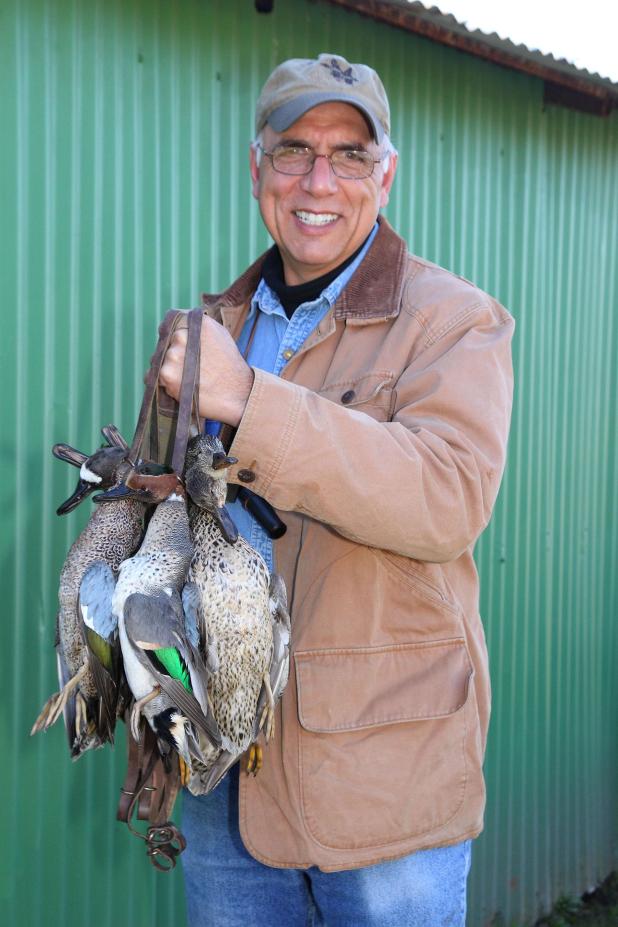
Photo courtesy of John K. Flores
The author, John K. Flores, shows a limit of ducks from White Lake Wildlife Conservation Area.
John K. Flores: Survey shows another decline in duck numbers
In mid-August the United States Fish & Wildlife Service released its data and findings of their 2023 Waterfowl Breeding Population and Habitat Survey. If you’re a waterfowl hunter, the news wasn’t good.
The survey, except for the 2020 and 2021 COVID-19 years, has been conducted in the U.S. and Canada since 1955. The study is the largest and most sophisticated research of its kind in the world, where great stock is placed on its results when it comes to waterfowl management.
This year’s total breeding duck population came in at an estimated 32.32 million ducks, down 5% from the 2022 survey of 34.21 million and 9% below the USF&WS long term average. The 2022 survey was down from the 2019 survey’s 38.90 million ducks.
These numbers reflect a trend that isn’t good when considering just under a decade ago in 2015, the breeding duck population reached an all-time record estimate of 49.5 million ducks.
According to a Delta Waterfowl Press Release issued Aug. 18, “The numbers might seem discouraging on the surface, but Dr. Frank Rohwer, president and chief scientist of Delta Waterfowl, puts forth an important reminder: ‘We don’t hunt the breeding population. We hunt the fall flight, which is made of the breeding population, plus this year’s duck production. Duck production is the key to the upcoming season.’”
Other data from the survey indicated that pond numbers were also down, estimated at 4.98 million. This habitat number is considered 5% below the long-term average and is down considerably from the 7.8 million ponds counted a decade ago, when breeding numbers were hitting record highs.
There are numerous reasons for declining duck numbers. There’s ethanol, where farmers have and are opting out of placing their land in the Conservation Reserve Program. The CRP. administered by the Farm Service Agency, pays farmers yearly rental payments for agreeing to remove environmentally sensitive land from agriculture production and plant species that will improve environmental health and quality. Contracts typically run 10 to 15 years. The thing about CRP is, it provides wildlife an opportunity to flourish.
There’s even hybrid corn that withstands cold allowing for states like North and South Dakota, which have shorter growing seasons, to produce a higher yield crop. Additionally, that crop is often still on the field when duck seasons are either closed or close to closing as winter arrives on their doorsteps.
No one can fault a farmer for trying to make a buck and opting out of CRP to plant more corn for ethanol production. Every little bit helps when putting the kids through college.
Then there’s poor to marginal habitat caused by severe drought, like the most recent 2020-21 period during COVID. Ducks need prairie grasses for nesting. During drought years there’s a huge decline in quality nesting habitat.
There’s also wetland loss in critical wintering habitat, like here in Louisiana. Coastal marshes provide valuable food resources that sustain ducks, preparing them for their return flight to the breeding grounds. If those ducks are lacking the fatty reserves required for spring migration, it impacts nest production.
Along the Louisiana coastline agricultural practices have changed as well. When I moved to Louisiana in 1984, rice was king, from Abbeville to Bell City along La. 14 in the southwestern part of the state. Now sugarcane is being grown right up to the doorstep of Gueydan.
I like sugar in my coffee and desserts same as any man, but sugar cane has no redeeming value from a wildlife standpoint. Unlike rice.
Ducks are also pressured today more than ever. There are surface drive motors that get hunters into locations where the ducks want to be. There are motion decoys. There are online migration sites that track waterfowl up and down the flyway, following their every movement.
Waterfowl need places to feed, rest and preen during the winter. Constant pressure is an important part of the equation when managing duck populations.
Perhaps the biggest issue with respect to duck harvest is climate change. For the past two years, I have been making at least one out-of-state hunt to try and experience waterfowl hunting different from Louisiana.
I hunted Kansas and Oklahoma in November and December, respectively. It was amazing how many ducks and geese are wintering in the mid-continent portions of the country. Number-wise, it reminded me of what duck hunting was like here in Louisiana in the late ’80s and ’90s.
Nonetheless, it is true, the breeding population survey isn’t an indicator of what the fall flight will ultimately be when the duck season opens in November. Rest assured, like a lot of diehard waterfowl hunters, I’ll be in the marsh come opening day.
Speaking of opening day, the special September teal season opens Friday, Sept. 15. With drought conditions and high temperatures across the southeast this summer, Louisiana being no exception, much of the state is dry.
I spent time in southwest Louisiana this past week, and many rice fields and crawfish ponds were void of water. Unless something changes in the next few weeks, like some serious rains, my guess is whoever has water will have ducks come opening day of teal season.
John Flores is the Morgan City Review’s outdoor writer. He can be contacted at gowiththeflo@cox.net.
